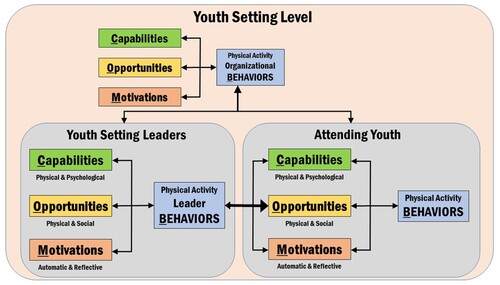Figures & data
© 2021 The Author(s). Published by Informa UK Limited, trading as Taylor & Francis Group
Table 1. Components of the COM-B framework of physical activity across levels of youth settings.
Table 2. Setting-specific intervention design considerations for capabilities, opportunities, and motivations to increase physical activity behaviors within the setting.
Figure 1. Multi-level COM-B theoretical framework for physical activity promotion in youth settings.
Note: Capability, opportunity, and motivation can be seen as setting-level features for the organization, which then influence the levels of leaders and attending youth. The COM-B components are hypothesized to be multidimensional composites within levels of setting, leader, and youth, so the plural form of each is used. Along with organizational influences, physical activity leader behaviors serve as key determinants of the physical activity levels of attending youth. The physical activity behaviors of attending youth will be the result of their own capabilities, opportunities, and motivations, where these components have been influenced by the behaviors of adult gatekeepers within the setting. Many relationships between COM-B components are reciprocal: Behaviors influence capabilities, opportunities, and motivations, and the COM-B components of youth have influence on the organization and youth setting physical activity leader behaviors.

